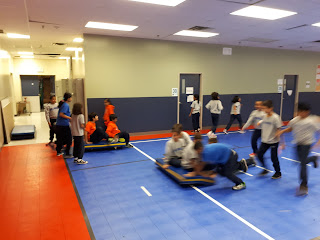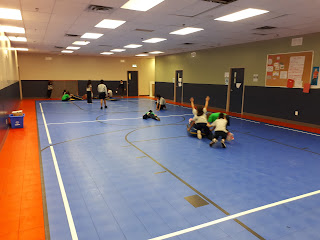Our Cooperative Games unit has come to an end and we are now doing a Target Games unit, the first category of Teaching Games for Understanding. Teaching Games for Understanding (TGfU) is a great way to develop student's skill and love for games, sports, and being active. Below is an explanation of the TGfU model, written a member of CIRA Ontario.
Teaching Games for Understanding (TGFU) is about teaching game concepts that can be used across many games. A give-and-go can be used in hockey, basketball, soccer, and a variety of other games. Rather than teach units on sports, particularly at the elementary school level, it is more beneficial for the students to learn game concepts, concepts that can be applied to a variety of similar game situations. The game concepts are divided into four categories of games from simplest to most complex. They are:
- Target--Hitting a stationary target
- Net/Wall--Throwing or hitting towards an open space
- Invasion--Moving and passing to an open space
- Striking/Fielding--Hitting targets; hitting towards open spaces; moving/passing/hitting fixed/open spaces
In addition, you may recall the story of Goldilocks and the Three Bears. Goldilocks declines two bowls of porridge because they are too hot or cold, and consumes one bowl of porridge that is the correct temperature. But if she would have cooled the hot porridge and heated the cold porridge she could have had three bowls of porridge. The same is true for games. You may find some games are too hot for your students, then cool them down by slowing down the pace, using a larger or softer or more slowly moving ball. You may find some games are too cool for your students, then heat them up by adding to the complexity of the games, or adding speed of a ball, or the increasing the movement of players.Permit one quick example of the above. Duck, Duck, Goose is a simple game sometimes played at the Kindergarten level. Children sit in a circle, one player walks around the circle touching each player on the head and saying, "Duck." When the circling player says, "Goose," those two players run around the circle, and the second player back to the open spot becomes the new player to walk around the circle... How do we heat this game up for older players. Rather than players sitting in a circle, players go in a plank position (laying forward in a push-up position, but resting on the player's forearms), and maintain that position till the circling player calls out, "Duck" (at which point the other players can lay down and take a break. A simple modification that makes Duck, Duck, Goose, and effective fitness activity for older participants.
We need to remember that we teach students first and content second. Keeping
that in mind, we need to adjust all the games that we do to help students
celebrate and enjoy their current levels of game play, and challenge them to
move to new levels.


















































